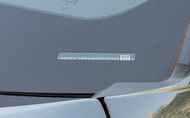What Is a VIN, and Why Does It Matter?
Sep 12th 2018
Every car has a distinct VIN, or Vehicle Identification Number, if it has been manufactured in 1981 or since. More than a nameplate or model designation from a manufacturer, a VIN of 17 letters and/or numbers “names” your individual car, SUV, pickup or van: No other vehicle has the same number as yours does.
That’s important, because in the event of a recall, a VIN specifically will show up in safety databases as a vehicle involved in a recall or not. If a car is stolen, the VIN also shows up in law enforcement databases of missing vehicles.
A VIN conveys even more detailed information. It tells you quite a bit about your vehicle—so much so that it can help you get the right parts for maintenance and repairs, or even sometimes flag a car that’s been involved in an accident.
The most obvious display of a VIN is on top of the dashboard. It can be seen only by looking through the windshield from outside the car. The second place it is attached is on the driver’s doorjamb, visible only when the door is open. The third place, seen only when you’re under the hood, is on the firewall.

What do VIN Numbers Mean?
1 through 3: World Manufacturer Identifier
The first character is the country of origin. Some have numbers (U.S., 1; Canada, 2). Others have a letter (Japan, J; Korea, K). The second digit identifies the manufacturer. For instance, G means General Motors. The third letter or number represents the type of vehicle. 1GC would mean a U.S.-made General Motors product, specifically a Chevrolet truck. Wikipedia has a list of World Manufacturer Identifiers.
4 through 8: Description
Here’s the part that tells you a lot about the parts you’ll need. These digits tell the model, the type of body it has, the kind of restraints, the transmission and the engine. All that information may have a bearing on replacement panels, transmission parts and spark plug type.
9: Check Number
Here’s where the regulators try to keep people honest. The ninth figure is applied so that a number cannot be easily made up in combination with the other letters and numbers. It reduces counterfeiting.
10 through 17: Identifiers
The 10th spot is very important: the year of manufacture. Vehicles from 1981 through 2000 used letters from B to Y, but no I, O, Q, U or Z. So, B was ’81, C as ’82, and so on. From 2001 to 2009, the corresponding single digit numbers 1-9 were used. Since 2010, the alphabet began again with A, again minus I, O, Q, U and Z. So, 2010 is A, 2011 is B, and so on.
Eleventh in the series is the plant number, with numbers assigned to each manufacturer. This can have consequences in recalls, especially if a vehicle is made at more than one plant.
Characters 12-17 are the serial number from that plant. These play a big role in recalls. If the numbers are 123456, the vehicle is the 123,456th vehicle made that model year in the plant indicated in character No. 11.
Check All the VIN Plates
If you’re considering the purchase of a used vehicle, check the numbers on all three VIN plates. If one is different, you know the vehicle has had a major repair. It probably is the product of a reconstruction, using the parts of two or more vehicles to make one that’s operable. Just walk away.
















